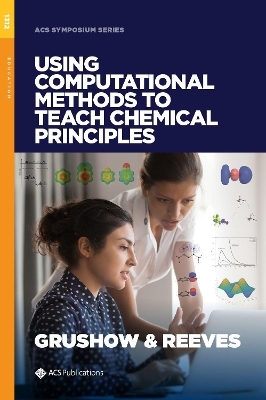
Using Computational Methods to Teach Chemical Principles
Oxford University Press Inc (Verlag)
978-0-8412-3420-8 (ISBN)
While computational chemistry methods are usually a research topic of their own, even in the undergraduate curriculum, many methods are becoming part of the mainstream and can be used to appropriately compute chemical parameters that are not easily measured in the undergraduate laboratory. These calculations can be used to help students explore and understand chemical principles and properties. Visualization and animation of structures and properties are also aids in
students' exploration of chemistry. This book will focus on the use of computational chemistry as a tool to teach chemical principles in the classroom and the laboratory.
Alexander Grushow received a B.A. in chemistry from Franklin & Marshall College and a Ph.D. from University of Minnesota. He is currently a Professor of Chemistry at Rider University and Chair of the Department of Chemistry, Biochemistry, and Physics. Since his days as an undergraduate, he has been fascinated by intermolecular forces and has published papers on molecules held together by hydrogen bonding, van der Waals forces, dative bonding and ion-molecule interactions. He has worked as a Program Director for the National Science Foundation and has worked in chemistry examination development for both ETS and the ACS Examinations Institute. He has also been heavily involved in innovating the teaching of physical chemistry; starting as a member of the Physical Chemistry Online Consortium (PCOL) and most recently as a coPI on two NSF grants to develop POGIL experiments in Physical Chemistry (POGIL-PCL). Melissa S. Reeves received her B.S. in chemistry at University of Florida and her Ph.D. in chemistry at Indiana University at Bloomington. She is an associate professor of chemistry at Tuskegee University, where she specializes in physical chemistry and computational chemistry. Her research interests have ranged from calculating transition states of small molecule reactions in solution to molecular dynamics of polymers. She was part of the Physical Chemistry Online (PCOL) group in the early 2000s, has worked on two American Chemical Society Physical Chemistry Exam Committees, and works as part of the Process Oriented Guided Inquiry Learning Physical Chemistry Laboratory (POGIL-PCL) community.
Chapter 1. Using Computational Methods To Teach Chemical Principles: Overview, Alexander Grushow and Melissa S. Reeves
Chapter 2. Molecular Dynamics Simulations in First-Semester General Chemistry: Visualizing Gas Particle Motion and Making Connections to Mathematical Gas Law Relationships, C. D. Bruce
Chapter 3. Using Electronic Structure Calculations To Investigate the Kinetics of Gas-Phase Ammonia Synthesis, Kelsey M. Stocker
Chapter 4. Modeling Reaction Energies and Exploring Noble Gas Chemistry in the Physical Chemistry Laboratory, James A. Phillips
Chapter 5. How Can You Measure a Reaction Enthalpy without Going into the Lab?, Melissa S. Reeves, H. Laine Berghout, Mark J. Perri, Steven M. Singleton, and Robert M. Whitnell
Chapter 6. Process Oriented Guided Inquiry Learning Computational Chemistry Experiments: Revisions and Extensions Based on Lessons Learned from Implementation, Robert M. Whitnell and Melissa S. Reeves
Chapter 7. Chem Compute Science Gateway: An Online Computational Chemistry Tool, Mark J. Perri, Mary Akinmurele, and Matthew Haynie
Chapter 8. Using Computational Chemistry to Extend the Acetylene Rovibrational Spectrum to C2T2, William R. Martin and David W. Ball
Chapter 9. Introducing Quantum Calculations into the Physical Chemistry Laboratory, Thomas C. DeVore
Chapter 10. Learning by Computing: A First Year Honors Chemistry Curriculum, Arun K. Sharma and Lukshmi Asirwatham
Chapter 11. Integrating Computational Chemistry into an Organic Chemistry Laboratory Curriculum Using WebMO, Brian J. Esselman and Nicholas J. Hill
Chapter 12. Computational Narrative Activities: Combining Computing, Context, and Communication To Teach Chemical Concepts, Steven M. Singleton
Chapter 13. Computational Chemistry as a Course for Students Majoring in the Sciences, Lorena Tribe
Chapter 14. Beyond the Analytical Solution: Using Mathematical Software To Enhance Understanding of Physical Chemistry, Ashley Ringer McDonald and John P. Hagen
Chapter 15. A Lab Course in Computational Chemistry Is Not About Computers, Alexander Grushow
Chapter 16. Discovery-Based Computational Activities in the Undergraduate ChemistryCurriculum, Yana Kholod and Dmytro Kosenkov
Chapter 17. Using the Hydrogen Bond as a Platform for the Enhancement of Integrative Learning, Harry L. Price
Editors' Biographies
Indexes
Author Index
Subject Index
| Erscheinungsdatum | 02.12.2019 |
|---|---|
| Reihe/Serie | ACS Symposium Series |
| Verlagsort | New York |
| Sprache | englisch |
| Maße | 185 x 258 mm |
| Gewicht | 846 g |
| Themenwelt | Naturwissenschaften ► Chemie ► Physikalische Chemie |
| ISBN-10 | 0-8412-3420-5 / 0841234205 |
| ISBN-13 | 978-0-8412-3420-8 / 9780841234208 |
| Zustand | Neuware |
| Haben Sie eine Frage zum Produkt? |
aus dem Bereich


